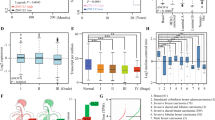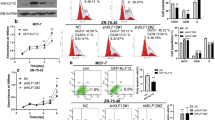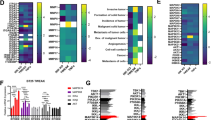Abstract
The Kruppel-like factor 5 (KLF5) transcription factor is highly expressed in high-grade and basal-like breast cancers. However, the mechanism by which KLF5 promotes cell migration and invasion is still not completely understood. In this study, we demonstrate that TNFAIP2, a tumor necrosis factor-α (TNFα)-induced gene, is a direct KLF5 target gene. The expression of TNFAIP2 is highly correlated with the expression of KLF5 in breast cancers. The manipulation of KLF5 expression positively alters TNFAIP2 expression levels. KLF5 directly binds to the TNFAIP2 gene promoter and activates its transcription. Functionally, KLF5 promotes cancer cell proliferation, migration and invasion in part through TNFAIP2. TNFAIP2 interacts with the two small GTPases Rac1 and Cdc42, thereby increasing their activities to change actin cytoskeleton and cell morphology. These findings collectively suggest that TNFAIP2 is a direct KLF5 target gene, and both KLF5 and TNFAIP2 promote breast cancer cell proliferation, migration and invasion through Rac1 and Cdc42.
This is a preview of subscription content, access via your institution
Access options
Subscribe to this journal
Receive 50 print issues and online access
$259.00 per year
only $5.18 per issue
Buy this article
- Purchase on Springer Link
- Instant access to full article PDF
Prices may be subject to local taxes which are calculated during checkout






Similar content being viewed by others
References
Maxmen A . The hard facts. Nature 2012; 485: S50–S51.
Dent R, Trudeau M, Pritchard KI, Hanna WM, Kahn HK, Sawka CA et al. Triple-negative breast cancer: clinical features and patterns of recurrence. Clin Cancer Res 2007; 13: 4429–4434.
Haffty BG, Yang Q, Reiss M, Kearney T, Higgins SA, Weidhaas J et al. Locoregional relapse and distant metastasis in conservatively managed triple negative early-stage breast cancer. J Clin Oncol 2006; 24: 5652–5657.
Ben-Porath I, Thomson MW, Carey VJ, Ge R, Bell GW, Regev A et al. An embryonic stem cell-like gene expression signature in poorly differentiated aggressive human tumors. Nat Genet 2008; 40: 499–507.
Chen CJ, Lin SE, Lin YM, Lin SH, Chen DR, Chen CL . Association of expression of kruppel-like factor 4 and kruppel-like factor 5 with the clinical manifestations of breast cancer. Pathol Oncol Res 2012; 18: 161–168.
Tong D, Czerwenka K, Heinze G, Ryffel M, Schuster E, Witt A et al. Expression of KLF5 is a prognostic factor for disease-free survival and overall survival in patients with breast cancer. Clin Cancer Res Research 2006; 12: 2442–2448.
Takagi K, Miki Y, Onodera Y, Nakamura Y, Ishida T, Watanabe M et al. Kruppel-like factor 5 in human breast carcinoma: a potent prognostic factor induced by androgens. Endocr Relat Cancer 2012; 19: 741–750.
Dong JT, Chen C . Essential role of KLF5 transcription factor in cell proliferation and differentiation and its implications for human diseases. Cell Mol Life Sci 2009; 66: 2691–2706.
Kojima S, Kobayashi A, Gotoh O, Ohkuma Y, Fujii-Kuriyama Y, Sogawa K . Transcriptional activation domain of human BTEB2, a GC box-binding factor. J Biochem 1997; 121: 389–396.
Sogawa K, Imataka H, Yamasaki Y, Kusume H, Abe H, Fujii-Kuriyama Y . cDNA cloning and transcriptional properties of a novel GC box-binding protein, BTEB2. Nucleic Acids Res 1993; 21: 1527–1532.
Aizawa K, Suzuki T, Kada N, Ishihara A, Kawai-Kowase K, Matsumura T et al. Regulation of platelet-derived growth factor-A chain by Kruppel-like factor 5: new pathway of cooperative activation with nuclear factor-kappaB. J Biol Chem 2004; 279: 70–76.
Bateman NW, Tan D, Pestell RG, Black JD, Black AR . Intestinal tumor progression is associated with altered function of KLF5. J Biol Chem 2004; 279: 12093–12101.
Suzuki T, Sawaki D, Aizawa K, Munemasa Y, Matsumura T, Ishida J et al. Kruppel-like factor 5 shows proliferation-specific roles in vascular remodeling, direct stimulation of cell growth, and inhibition of apoptosis. J Biol Chem 2009; 284: 9549–9557.
Zhu N, Gu L, Findley HW, Chen C, Dong JT, Yang L et al. KLF5 interacts with p53 in regulating survivin expression in acute lymphoblastic leukemia. J Biol Chem 2006; 281: 14711–14718.
He M, Han M, Zheng B, Shu YN, Wen JK . Angiotensin II stimulates KLF5 phosphorylation and its interaction with c-Jun leading to suppression of p21 expression in vascular smooth muscle cells. J Biochem 2009; 146: 683–691.
Wang C, Nie Z, Zhou Z, Zhang H, Liu R, Wu J et al. The interplay between TEAD4 and KLF5 promotes breast cancer partially through inhibiting the transcription of p27Kip1. Oncotarget 2015, e-pub ahead of print 22 April 2015.
Zheng HQ, Zhou Z, Huang J, Chaudhury L, Dong JT, Chen C . Kruppel-like factor 5 promotes breast cell proliferation partially through upregulating the transcription of fibroblast growth factor binding protein 1. Oncogene 2009; 28: 3702–3713.
Xia H, Wang C, Chen W, Zhang H, Chaudhury L, Zhou Z et al. Kruppel-like factor 5 transcription factor promotes microsomal prostaglandin E2 synthase 1 gene transcription in breast cancer. J Biol Chem 2013; 288: 26731–26740.
Yang Y, Tetreault MP, Yermolina YA, Goldstein BG, Katz JP . Kruppel-like factor 5 controls keratinocyte migration via the integrin-linked kinase. J Biol Chem 2008; 283: 18812–18820.
Chen C, Benjamin MS, Sun X, Otto KB, Guo P, Dong XY et al. KLF5 promotes cell proliferation and tumorigenesis through gene regulation and the TSU-Pr1 human bladder cancer cell line. Int J Cancer 2006; 118: 1346–1355.
Sarma V, Wolf FW, Marks RM, Shows TB, Dixit VM . Cloning of a novel tumor necrosis factor-alpha-inducible primary response gene that is differentially expressed in development and capillary tube-like formation in vitro. J Immunol 1992; 148: 3302–3312.
Wolf FW, Sarma V, Seldin M, Drake S, Suchard SJ, Shao H et al. B94, a primary response gene inducible by tumor necrosis factor-alpha, is expressed in developing hematopoietic tissues and the sperm acrosome. J Biol Chem 1994; 269: 3633–3640.
Chevrier N, Mertins P, Artyomov MN, Shalek AK, Iannacone M, Ciaccio MF et al. Systematic discovery of TLR signaling components delineates viral-sensing circuits. Cell 2011; 147: 853–867.
Ma Y, Koza-Taylor PH, DiMattia DA, Hames L, Fu H, Dragnev KH et al. Microarray analysis uncovers retinoid targets in human bronchial epithelial cells. Oncogene 2003; 22: 4924–4932.
Hase K, Kimura S, Takatsu H, Ohmae M, Kawano S, Kitamura H et al. M-Sec promotes membrane nanotube formation by interacting with Ral and the exocyst complex. Nat Cell Biol 2009; 11: 1427–1432.
Kimura S, Hase K, Ohno H . Tunneling nanotubes: emerging view of their molecular components and formation mechanisms. Exp Cell Res 2012; 318: 1699–1706.
Chen LC, Chen CC, Liang Y, Tsang NM, Chang YS, Hsueh C . A novel role for TNFAIP2: its correlation with invasion and metastasis in nasopharyngeal carcinoma. Mod Pathol 2011; 24: 175–184.
Zhao D, Zheng HQ, Zhou Z, Chen C . The Fbw7 tumor suppressor targets KLF5 for ubiquitin-mediated degradation and suppresses breast cell proliferation. Cancer Res 2010; 70: 4728–4738.
Zhao D, Zhi X, Zhou Z, Chen C . TAZ antagonizes the WWP1-mediated KLF5 degradation and promotes breast cell proliferation and tumorigenesis. Carcinogenesis 2012; 33: 59–67.
Ridley AJ, Schwartz MA, Burridge K, Firtel RA, Ginsberg MH, Borisy G et al. Cell migration: integrating signals from front to back. Science 2003; 302: 1704–1709.
Vega FM, Ridley AJ . Rho GTPases in cancer cell biology. FEBS Lett 2008; 582: 2093–2101.
McConnell BB, Bialkowska AB, Nandan MO, Ghaleb AM, Gordon FJ, Yang VW . Haploinsufficiency of Kruppel-like factor 5 rescues the tumor-initiating effect of the Apc(Min) mutation in the intestine. Cancer Res 2009; 69: 4125–4133.
Liu R, Zhou Z, Zhao D, Chen C . The induction of KLF5 transcription factor by progesterone contributes to progesterone-induced breast cancer cell proliferation and dedifferentiation. Mol Endocrinol 2011; 25: 1137–1144.
Bafford R, Sui XX, Wang G, Conte M . Angiotensin II and tumor necrosis factor-alpha upregulate survivin and Kruppel-like factor 5 in smooth muscle cells: potential relevance to vein graft hyperplasia. Surgery 2006; 140: 289–296.
Chanchevalap S, Nandan MO, McConnell BB, Charrier L, Merlin D, Katz JP et al. Kruppel-like factor 5 is an important mediator for lipopolysaccharide-induced proinflammatory response in intestinal epithelial cells. Nucleic Acids Res 2006; 34: 1216–1223.
Mori A, Moser C, Lang SA, Hackl C, Gottfried E, Kreutz M et al. Up-regulation of Kruppel-like factor 5 in pancreatic cancer is promoted by interleukin-1beta signaling and hypoxia-inducible factor-1alpha. Mol Cancer Res 2009; 7: 1390–1398.
Sur I, Unden AB, Toftgard R . Human Kruppel-like factor5/KLF5: synergy with NF-kappaB/Rel factors and expression in human skin and hair follicles. Eur J Cell Biol 2002; 81: 323–334.
Chen C, Bhalala HV, Qiao H, Dong JT . A possible tumor suppressor role of the KLF5 transcription factor in human breast cancer. Oncogene 2002; 21: 6567–6572.
Hall A . Rho GTPases and the actin cytoskeleton. Science 1998; 279: 509–514.
Ohta Y, Suzuki N, Nakamura S, Hartwig JH, Stossel TP . The small GTPase RalA targets filamin to induce filopodia. Proc Natl Acad Sci USA 1999; 96: 2122–2128.
Ikeda M, Ishida O, Hinoi T, Kishida S, Kikuchi A . Identification and characterization of a novel protein interacting with Ral-binding protein 1, a putative effector protein of Ral. J Biol Chem 1998; 273: 814–821.
Ohno H, Hase K, Kimura S . M-Sec: emerging secrets of tunneling nanotube formation. Commun Integr Biol 2010; 3: 231–233.
Abounit S, Zurzolo C . Wiring through tunneling nanotubes—from electrical signals to organelle transfer. J Cell Sci 2012; 125: 1089–1098.
Davis DM, Sowinski S . Membrane nanotubes: dynamic long-distance connections between animal cells. Nat Rev Mol Cell Biol 2008; 9: 431–436.
Gerdes HH, Bukoreshtliev NV, Barroso JF . Tunneling nanotubes: a new route for the exchange of components between animal cells. FEBS Lett 2007; 581: 2194–2201.
Schiller C, Diakopoulos KN, Rohwedder I, Kremmer E, von Toerne C, Ueffing M et al. LST1 promotes the assembly of a molecular machinery responsible for tunneling nanotube formation. J Cell Sci 2013; 126: 767–777.
Shi X, Liu M, Li D, Wang J, Aneja R, Zhou J . Cep70 contributes to angiogenesis by modulating microtubule rearrangement and stimulating cell polarization and migration. Cell Cycle 2012; 11: 1554–1563.
Chen C, Sun X, Ran Q, Wilkinson KD, Murphy TJ, Simons JW et al. Ubiquitin-proteasome degradation of KLF5 transcription factor in cancer and untransformed epithelial cells. Oncogene 2005; 24: 3319–3327.
Shi H, Zhang Z, Wang X, Liu S, Teng CT . Isolation and characterization of a gene encoding human Kruppel-like factor 5 (IKLF): binding to the CAAT/GT box of the mouse lactoferrin gene promoter. Nucleic Acids Res 1999; 27: 4807–4815.
Chen C, Zhou Z, Ross JS, Zhou W, Dong JT . The amplified WWP1 gene is a potential molecular target in breast cancer. Int J Cancer 2007; 121: 80–87.
Acknowledgements
We thank Professor Jun Zhou at Nankai University for providing reagents and Professor Ping Wang from Tongji University for bioinformatics analysis. This study was supported by the Strategic Priority Research Program of the Chinese Academy of Sciences, Stem Cell and Regenerative Medicine Research (XDA01040406) and the National Natural Science Foundation of China (81120108019, 81325016, U1132605, 81322038 and 81272930) West Light Foundation of Chinese Academy of Sciences (to RL) and Shanghai Health System outstanding academic leader training program (XBR2013114 to JF).
Author contributions
LJ conceived, performed most experiments and analyzed the data. ZZ, ZW, JW, CW, HZ, PS, FL, HL, YW, WC and RL assisted or performed experiments and analyzed the data. CC and JF conceived the project, designed experiments, analyzed the data and wrote the manuscript.
Author information
Authors and Affiliations
Corresponding authors
Ethics declarations
Competing interests
The authors declare no conflict of interest.
Additional information
Supplementary Information accompanies this paper on the Oncogene website
Supplementary information
Rights and permissions
About this article
Cite this article
Jia, L., Zhou, Z., Liang, H. et al. KLF5 promotes breast cancer proliferation, migration and invasion in part by upregulating the transcription of TNFAIP2. Oncogene 35, 2040–2051 (2016). https://doi.org/10.1038/onc.2015.263
Received:
Revised:
Accepted:
Published:
Issue Date:
DOI: https://doi.org/10.1038/onc.2015.263
This article is cited by
-
Screening UFMylation-associated genes in heart tissues of Ufm1-transgenic mice
BMC Cardiovascular Disorders (2023)
-
TNFAIP2 confers cisplatin resistance in head and neck squamous cell carcinoma via KEAP1/NRF2 signaling
Journal of Experimental & Clinical Cancer Research (2023)
-
The FUS/circEZH2/KLF5/ feedback loop contributes to CXCR4-induced liver metastasis of breast cancer by enhancing epithelial-mesenchymal transition
Molecular Cancer (2022)
-
Pan-cancer analysis of oncogenic TNFAIP2 identifying its prognostic value and immunological function in acute myeloid leukemia
BMC Cancer (2022)
-
Inhibitory effect of the novel tyrosine kinase inhibitor DCC-2036 on triple-negative breast cancer stem cells through AXL-KLF5 positive feedback loop
Cell Death & Disease (2022)



